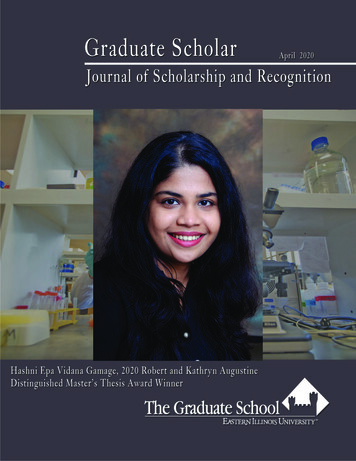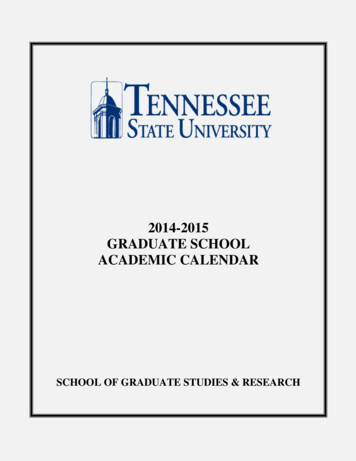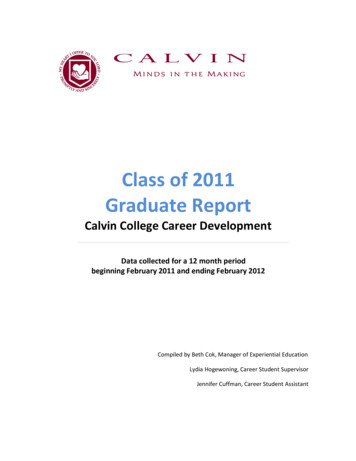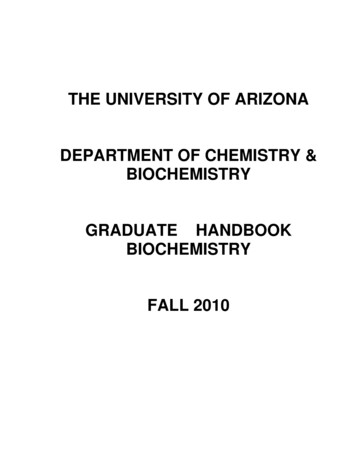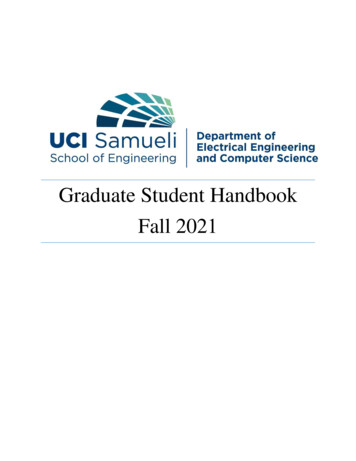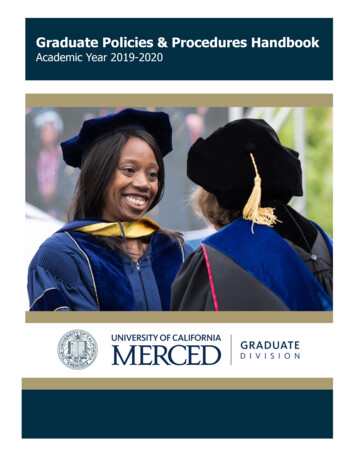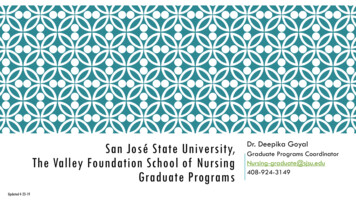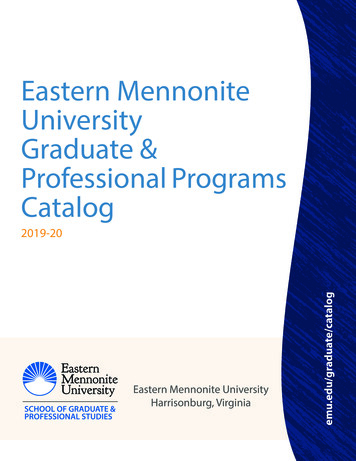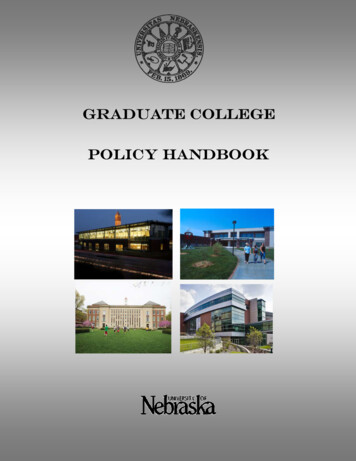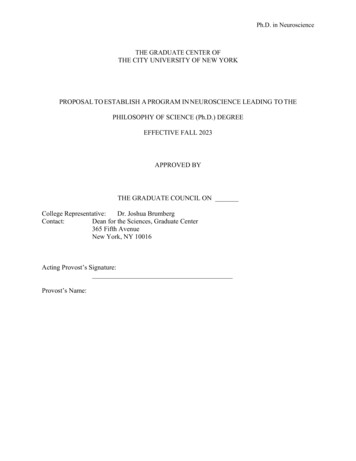
Transcription
Ph.D. in NeuroscienceTHE GRADUATE CENTER OFTHE CITY UNIVERSITY OF NEW YORKPROPOSAL TO ESTABLISH A PROGRAM IN NEUROSCIENCE LEADING TO THEPHILOSOPHY OF SCIENCE (Ph.D.) DEGREEEFFECTIVE FALL 2023APPROVED BYTHE GRADUATE COUNCIL ONCollege Representative:Dr. Joshua BrumbergContact:Dean for the Sciences, Graduate Center365 Fifth AvenueNew York, NY 10016Acting Provost’s Signature:Provost’s Name:
Ph.D. in NeuroscienceTABLE OF CONTENTSEXECUTIVE SUMMARYABSTRACTPURPOSE AND GOALSNEED AND JUSTIFICATIONSTUDENTSA. Interest/DemandB. Enrollment ProjectionsC. Admission RequirementsCURRICULUMCOST ASSESSMENTA. FacultyB. Facilities and EquipmentC. Budget TablesGOVERNANCEEVALUATIONAPPENDIX A: SAMPLE JOB LISTINGSAPPENDIX B: COURSE DESCRIPTIONS FOR REQUIRED COURSESAPPENDIX C: FACULTY INFORMATION AND TEACHING ASSIGNMENTSAPPENDIX D: SURVEY INSTRUMENT AND RESULTSAPPENDIX E: EXTERNAL REVIEWERSAPPENDIX F: PROJECT REVENUE AND EXPENSESAPPENDIX G. SED AND CUNY FORMS FOR ACADEMIC PROGRAMS
Ph.D. in NeuroscienceEXECUTIVE SUMMARYWe propose a new Doctor of Philosophy (Ph.D.) program in Neuroscience, a highlyinterdisciplinary field that focuses on understanding all aspects of brain function, development,injury, and degeneration. The Graduate Center (GC) is ideally suited to house this Ph.D.Program in Neuroscience (NEURO) for the following reasons:1) There are over 80 CUNY faculty members who are actively involved in neuroscienceresearch and training and who already participate in Training Areas in Biology(Neuroscience) and Psychology (Behavioral and Cognitive Neuroscience) DoctoralPrograms operating under an interim umbrella organization (CUNY NeuroscienceCollaborative: CNC). This new, independent interdisciplinary Neuroscience Programwill draw upon the strengths and numbers of existing faculty with primary appointmentsin different departments across 8 CUNY campuses.2) Students in this doctoral program will be able take advantage of the already existingneuroscience-related infrastructure and activities of Biology (Neuroscience) andPsychology (Behavioral and Cognitive Neuroscience) Doctoral training areas at the GC.In addition, the interdisciplinary nature of the program is strengthened by includingfaculty from Computer Science, Speech-Language-Hearing Sciences, Engineering, andother doctoral programs.3) Students will have access to and will gain research experience in state-of-the-artlaboratories and research facilities within the GC as well as on the campuses, in additionto the state-of-the-art magnetic resonance imaging (MRI) scanner that is installed at theAdvanced Science Research center (ASRC). The GC’s central location will facilitate theability of first year students to complete their coursework and interact with facultymembers from different CUNY colleges.The current CUNY Neuroscience Collaborative (CNC), which is jointly administered betweenthe doctoral programs in Biology (Neuroscience) and Psychology (Behavioral & CognitiveNeuroscience), admits approximately 10 doctoral students per year. We anticipate that NEUROwill initially admit 10 students per year and propose transferring the current fellowship lines inthe NS subprogram and BCN training program to NEURO. Depending on the demand fromfaculty and the size of the applicant pool, this number will be adjusted appropriately in futureyears.This program will offer students unique opportunities to conduct leading research inNeuroscience. Students graduating from this program will be well-positioned to securepostdoctoral opportunities in academia as well as industry. This program will benefit the largenumber of CUNY faculty interested in teaching graduate level courses and training motivatedstudents to conduct research in their laboratories.
Ph.D. in NeuroscienceABSTRACTThis proposal is to establish a doctoral Program in Neuroscience (NEURO) at the GraduateCenter. This interdisciplinary program will bring together research faculty whose researchinterests span all aspects of nervous system function, ranging from neurodevelopment tocognitive functions. The program will be based and administered through the Graduate Centerof the City University of New York (CUNY) and will involve over 80 faculty members from theDepartments of Biology/Biological Sciences, Psychology, Physics, Biomedical Engineering,Mathematics, and Molecular, Cellular & Biomedical Sciences from 8 different CUNY campuses,including the CUNY School of Medicine and Graduate Center. Most recently, CUNY has beenactively hiring new faculty in the neurosciences, forming a neuroscience core at the AdvancedScience Research Center (ASRC) and CUNY School of Medicine and investing in infrastructurefor conducting neuroscience research at the ASRC and the campuses. The breadth of expertiseamong the faculty will create a multidisciplinary platform in which our students will be trained.
Ph.D. in NeurosciencePURPOSE AND GOALSIn the past two decades, neuroscientists across the CUNY senior campuses have been workingcollaboratively towards building a Doctoral Program in Neuroscience at the Graduate Center(GC). The CUNY Neuroscience Collaborative (CNC) bridges the Neuroscience doctoralsubprogram in Biology and the Behavioral and Cognitive Neuroscience doctoral trainingprogram in Psychology to focus on research related to how the nervous system is generated(neurodevelopment), functions, and is maintained. There is now strong support for broadeningthe CNC coalition and establishing a standalone Neuroscience doctoral program that unifies allaspects of Neuroscience research under one umbrella at the GC. This new doctoral program,Program in Neuroscience (NEURO), will be initiated with over 80 faculty members activelyengaged in different areas of neuroscience research across the CUNY senior campuses,Advanced Science Research Center (ASRC), and GC. It will increase CUNY’s visibility in theneurosciences, enhance graduate student and faculty recruiting efforts, and facilitatecollaborations among the existing faculty across campuses. The main objective of this DoctoralProgram in Neuroscience is to attract and educate doctoral students and award them with a Ph.D.in Neuroscience rather than Biology, Psychology, Biomedical Engineering, or other relatedfields. A single administrative structure, curriculum, faculty body, and website are proposed thatwould facilitate and emphasize the unity of this Doctoral Program in Neuroscience at CUNY.The formation of this doctoral program would also facilitate course scheduling and the teachingcurriculum for the doctoral students. This program responds to the growing need to traingraduate students with interdisciplinary approaches to solving problems in the neurosciences.The program will take advantage of the rich neuroscience expertise at CUNY and will bestructured for students to develop an understanding of the nervous system at all levels ofanalysis—cellular, molecular, developmental, systems, behavioral, and cognitive levels. Themain goals of this program will be to:1) Provide the students with an opportunity to gain essential coursework and researchexperience in Neuroscience, a field of great importance and interest and one that affectsresearch in many disciplines.2) Offer students of this program a wide range of elective and specialized courses, whichwill also provide the opportunity for our faculty to teach courses in their areas ofexpertise.3) Provide students with professional development opportunities, allowing them to becompetitive for postdoctoral fellowships and academic, pharmaceutical, venturecapitalist, and biotechnology jobs post-graduation.4) Bring under one academic roof the faculty and resources to further the study ofNeuroscience.NEED AND JUSTIFICATIONAmong the US population, 16 million people show cognitive impairment with age being thegreatest risk factor.1 The effects of cognitive impairment affect not only the patient, but also thefamily and caregivers. The aging of the baby boomer generation led to the recognition that this1https://www.cdc.gov/aging/pdf/cognitive impairment/cogimp poilicy final.pdf
Ph.D. in Neuroscienceproblem would accelerate over time and that our understanding of cognitive functions waswoefully lacking. This recognition led to the declaration of the 1990s as the “Decade of theBrain” by former President George Bush. Subsequently, former President Barack Obamaannounced the National Alzheimer’s Project Act (NAPA)2 in 2011, followed with the signing ofthe Brain Research through Advancing Innovative Neurotechnologies (BRAIN) Initiative3 in2013. These Presidential initiatives highlighted the importance of understanding brain functionfrom its development to its decline, and called on scientists from all disciplines to contributetowards these research efforts. Despite the significant inroads into deciphering how the brainfunctions at the cellular level and how brain activity gives rise to perception, movement, andcognition, there is still little understanding of these mechanisms and what triggers the onset ofcognitive decline. The job prospects for a Ph.D. in Neuroscience, based on occupationalprojections for medical scientists with a Ph.D. degree, are on an upward trajectory, with an 8%job growth predicted between 2018-2028 and a 84,810 median pay.4One major problem in recruiting doctoral students in Neuroscience to the CUNY GC is theexistence of many, small competing programs in Neuroscience-related fields. Hence,candidates to these programs receive the impression that there are a limited number ofNeuroscience faculty members as potential research mentors. This appearance, despite thewealth of Neuroscience faculty at CUNY (over 80 faculty members), disadvantages ourstudents and programs. By unifying these smaller programs into one multi-disciplinaryprogram, CUNY can truly present its research diversity and expertise in Neuroscience andprovide students with a broad-based, multi-disciplinary program. The proposed program willgive students training in both experimental and cognitive approaches to understanding neuralsystems at both the cellular/molecular and the systems/behavioral levels of analysis. Theseneuroscientists will be exceptionally well-qualified for research careers in academia andindustry.Currently, most graduate students interested in the Neurosciences apply to a particulardepartment, such as Biology, Psychology, Mathematics, or Biomedical Engineering. If admitted,a student takes the prescribed curriculum within his/her respective department. However, whilethis approach has been successful in giving students a thorough grounding in one discipline ofneuroscience, this training has not integrated or exposed students to the many subdisciplineswithin neuroscience, nor has this training exposed students to the rich resources in neurosciencesat CUNY. In addition, this scattershot approach decreases our recruitment efforts. A formalgraduate degree program in Neuroscience would centralize the neuroscience efforts at CUNY,and serve to increase the visibility of the graduate opportunities and research interests of thefaculty for graduate student recruitment. Furthermore, such a program can sparkinterdepartmental collaborations both in research (e.g., joint mentoring of a graduate student byfaculty advisors from two departments or two campuses) and in teaching, as is currentlyoccurring in the required basic Neuroscience course sequence (see below). From a student’sstandpoint, the need for such a doctoral program is very exciting: the possibility of choosingamong so many neuroscientists for their doctoral research and the expertise available to helpthem throughout their doctoral years is appealing. Anecdotally, when the proposal h.gov4Occupational Outlook Handbook, Life, Physical, and Social Science: Medical Scientists, 2019.3
Ph.D. in Neurosciencediscussed with some first-year Biology Neuroscience students, all seven indicated that theywould submit paperwork to have their degree be in Neuroscience.Graduates from this program will be well-positioned to obtain jobs in medical imaging, datascience, the pharmaceutical and biotechnology industries, and other related fields, all of whichrepresent growing areas in our local and national economies (see Appendix A for sample joblistings). At the state level, there has also been investment in Neuroscience. For instance,Governor Andrew Cuomo announced in 2016 a 650 million initiative to fuel growth in the lifesciences5, which is anticipated to create more than 25,000 new jobs. Mayor Bill de Blasiosubsequently followed suit by announcing a LifeSciNYC initiative6, which invests 500 millionin the life sciences that will lead to the creation of approximately 16,000 jobs, 9,000 in lifesciences and 7,000 in related fields. These announcements suggest that students graduating fromthis program will have an opportunity for higher earning potential with many job opportunities ina wide range of related fields.There are several Neuroscience programs in New York City, including at Columbia University,Cornell University Weill School of Medical Sciences, State University of New York HealthScience Center, Albert Einstein College of Medicine, and New York University. The CUNYNEURO would be the first Neuroscience program at a public university that brings togetherfaculty from such a wide range of disciplines.Student Interest/EnrollmentEnrollment ProjectionsThis multi-disciplinary program will draw from students with a wide range of expertise.Currently, the Biology Neuroscience subprogram and the Psychology Behavioral and CognitiveNeuroscience (BCN) training program jointly admit 10 students per year, which translatesroughly to 10% of its applicants. The majority of the students entering the CNC doctoralprogram are highly competitive and have had extensive research experiences; many have alreadyobtained master’s degrees from other universities. Our current CNC enrollments are 31 doctoralcandidates in Biology in the Neuroscience subprogram and 28 in the BCN training program.These enrollment levels have been kept low so that we can provide students with better financialsupport. The students currently receive financial support from the GC in years 1 and 5. We willinitially stay with this model. All students will be full-time and we anticipate an attrition rate of20%, which is slightly lower than what we currently see with our Biology students (attrition rate:25% out of 72 students between 2001-2010). Of the students who graduated, 33.3% and 55.5%graduated within 5 and 6 years, respectively, in the 2001-2010 cohort (n 54). We, therefore,expect a steady state of 65-70 students after year 5, when we expect that 33.3% of the first cohortof students will graduate.Table 1. Projected student enrollments in the Ph.D. Program in Neuroscience.YEAR IYEAR IIYEAR ont.56Life sciences initiatives at https://www.governor.ny.govLife sciences initiatives at http://www1.nyc.govYEAR IV2026-2027NewCont.YEAR V2027-2028NewCont.
Ph.D. in 20Admissions Requirements and Student AdvisementProspective students are expected to have strong undergraduate backgrounds in Biology,Biomedical Engineering, Mathematics, Physics, Chemistry, and/or Psychology and to desireneuroscience training in experimental methodologies. Previous research experience is highlyencouraged. In the last three years, only two out of 18 students in the Biology NS subprogramcame directly from their undergraduate studies; the remaining students had enrolled in anMA/MS program (9 students), worked as a research technician (7 students), and many (10students) were already co-authors on a publication. All students enrolling in this doctoralprogram will have received a bachelor’s degree or equivalent from a four-year accrediteduniversity with a typical criterion of at least a 3.0 GPA on a 4.0 scale. Although the GREs willnot be required, they will be optional to show proficiency in quantitative skills and reasoning forstudents who have not done well with their college quantitative courses. For students applyingfrom non-English speaking countries, a score of at least 75% on the Internet-based test (iBT) orpaper-based test (PBT) on the TOEFL exam, IELTS test, or PTE test is required. Studentsapplying to this program will also be required to submit a curriculum vitae, at least three lettersof recommendation, preferably from researchers with whom the student has performed research,and a statement of purpose describing the student’s interests, relevant experience, andmotivations for applying to the program.Upon admission into the program, each student will be sent the graduate student handbook forNEURO and information about a Neuroscience orientation and a Science Day orientation inAugust of the year of matriculation. The Neuroscience orientation will give students specificinformation about the program (course requirements, thesis requirements, etc.) and will help thestudents register for classes, make sure students get GC email accounts and ID cards, etc. Thestudents will also be informed about their guaranteed financial support for their first five years:namely, students will be supported by the GC for year 1 to provide them with maximal flexibilityin taking required courses and finding their research laboratory and be supported by theirresearch campus in years 2-4 with year 5 again supported by the GC, consistent with the currentCNC model. The Science Day orientation will be conducted with other incoming bench sciencegraduate students and include welcoming remarks from the provost, a program overview fromthe Dean of Sciences, and talks from different offices (e.g., Career Planning, Teaching andLearning Center, Research and Sponsored Programs, Responsible Conduct for Research, and theLibrary). We will have a poster session of current research ongoing in laboratories that areinterested in recruiting graduate students. Based on their interests, the students will select two orthree laboratories in which to rotate for students to subsequently decide their research mentor.Students will be assigned a 3-member advisory committee within their first 2 months in theprogram; this committee will consist of the 2 or 3 rotation mentors plus an additional facultymember (if needed) with related research interests. This committee will advise the student until apermanent lab/research mentor is chosen and will administer the 1st level doctoral exam to thestudent.32131403
Ph.D. in NeuroscienceBy April 15 of their first year, students will identify their research labs, and the ExecutiveOfficer (EO) will ensure that the campus accepts the students and has a funding source for thestudents’ financial support in years 2-4. Each student will continue to have an AdvisoryCommittee composed of three faculty members in the NEURO program (including the advisor);once the student has chosen a research mentor, this committee may be the same members asthose who advise the student during the 1st year and who administer the 1st level exam, butalternate faculty may be chosen if appropriate given the selected lab’s research focus. Thiscommittee will meet with the student each semester to provide guidance on the student’scurriculum and research, and to ensure that the student makes good academic and researchprogress. The Neuroscience office, supported by an Academic Program Officer (APO) andCollege Assistant (CA), will maintain academic records for each student, including files of eachstudent’s grades, and minutes of the student’s annual meetings and progress towards meetingtheir degree requirements. Any issues flagged by the NEURO staff will be brought to theattention of the EO.CURRICULUMThe course curriculum for this doctoral program will be similar to the curriculum for the CUNYNeuroscience Collaborative (CNC) doctoral program. We will make modest revisions to improvethe curriculum. These include splitting the two core courses, NSI and NSII into smaller unitswith more clearly defined content. Students must have at least 60 credits of approved graduatework; the credits must be 70000 and 80000-level courses. Up to 10 (typically 5) credits persemester can be earned in Advanced Study and/or Independent Doctoral Research in years 2 and3 in the program. The required curriculum for this program is as follows (see Appendix B forcourse descriptions):Required Core Courses (12 credit hours)NEUR 70001: NSI: Neuroanatomy (3 cr)NEUR 70002: NSII: Neurophysiology (3 cr)NEUR 70003: NSIII: Molecular and Developmental Neuroscience (3 cr)NEUR 70004: NSIV: Integrative and Translational Neuroscience (3 cr)NEUR 70005: NSV: Science Writing and Communication (3 cr)Quantitative Courses (one basic and one advanced course required, min 6 credit hours)Options for basic course:PSYC (cross list NEUR) 70500: Statistical Methods in Psychology I (3 cr)BIOL (cross list NEUR) 78001: Mathematical Biology: Lecture and Lab (3 cr)BIOL (cross list NEUR) 78201: Biostatistics I (3 cr)others with approval of the DirectorStudents may select any advanced quantitative course consistent with their needs and interest tosatisfy the advanced requirement.Note: BIOL 78001 has lecture and lab, 3 credits each. Only 3 of 6 credits can apply to basicquantitative requirement and neither can apply toward advanced quantitative requirement.
Ph.D. in NeuroscienceColloquium and ethics (10 credits)NEUR 79300: Colloquium: Neuroscience (2 credit hours), to be taken 4 semestersNEUR 79301: Ethical principles in Research and Professional Development (2 credit hours)Elective Courses (8-10 credit hours)Elective courses (3-4) are intended to allow students to deepen their knowledge in areas specificto their research and career aspirations. The program will suggest clusters of electives that wouldbe appropriate for (a) cognitive neuroscience, (b) clinical/translational neuroscience, (c)molecular neuroscience, (d) developmental neuroscience, (e) behavioral neuroscience withanimal models and (f) computational neuroscience. These will be only suggested groupings ofelectives and not formal tracks or requirements.Research Courses (with prefix changed to NEUR)NEUR 71101: Lab Rotation, 3 credit hours, at least two in year 1NEUR 89800: Advanced Study (1-10 credit hours/semester)NEUR 89900: Independent Doctoral Research (1-10 credit hours/semester)Rationale for Required CoursesNeuroscience I through V: The required Neuroscience course sequence provides foundationalmaterial in the Neurosciences, including:I. Neuroanatomy, emphasizing functional circuits and systemsII. Neurophysiology, cellular and electrical properties of neurons and gliaIII. Molecular and Developmental Neuroscience, neurochemistry, including subcellularsignaling pathwaysIV. Integrative and Translational Neuroscience, intent is to put together knowledge fromthree prior courses into more integrative, ‘higher level’ study of brain function in healthand disease, including cognitive neuroscienceV. Science writing and communication, will focus on effective communication, with anemphasis on preparing second doctoral examination in NRSA format but includingother modes of communication, such as scientific talks and communicating andpromoting science to the publicQuantitative Courses: A basic course in statistics and quantitative methods is required to ensurestudents are properly trained to evaluate their data rigorously. An advanced quantitativecourse is intended to allow students to develop methods particularly suited for theirwork, such as bioinformatics, quantitative genetics, imaging methods and analysis andso on.Colloquium: Neuroscience: To ensure that students become familiar with cutting-edge researchas well as become accustomed and comfortable with the culture of science, students willattend a Neuroscience colloquium series for the first two years at the Graduate Center.In the third year and beyond, it is expected that students will participate in the colloquiaby presenting their work.Ethics: To ensure that all students are well versed in research ethics, students will be required totake an ethics course.OTHER REQUIREMENTS
Ph.D. in NeuroscienceIn addition to coursework, the program will require that students accrue professionaldevelopment hours over the course of their doctoral work. This would include workshops andtraining in pedagogy, teaching or mentoring, career workshops (e.g., workshops on alternativejobs, such as publishing, tech transfer and so on), workshops geared toward communicating anddisseminating your work to the public, workshops focused organizational skills (e.g., ‘how to runa lab). Routine requirements (e.g., online CITI courses for IACUC approval, IRB) will not countas the intent is to ensure students look outside the classroom and laboratory and consider careerdevelopment and options prior to completing their PhD. The guidelines, requirements andtracking of professional development will be developed by the executive committee.First ExaminationThe 1st level (qualifying) doctoral examination covers the student’s ability to think, synthesizeinformation, integrate different scientific literatures (one of which may be in the student’simmediate research area), and solve problems in Neuroscience. The goal is for students to showthat they can tie what they already know to relevant and unfamiliar information. This is NOT (asin the subsequent 2nd level exam (thesis proposal) aimed at simply summarizing and marshalingprior work to propose a series of experiments for their thesis. Students will meet with theiradvisory committee to decide upon the assigned topic for which they will write a critical minireview/analysis leading to a testable hypothesis and preliminary research design. Each facultymember will give the student several papers to read, and the student is given 2 weeks to writeand submit the document to the committee. If they agree it is satisfactory, the student will thentake an oral examination to assess the breadth and depth of the candidate’s understanding of thereading, and the ability to critique past experiments and generate new testable hypotheses. Theexamination must be taken and passed by the end of June.Second Examination & Advancement to CandidacyStudents must demonstrate advanced understanding and research competence in their area ofspecialization and related fields of neuroscience by passing a written and oral SecondExamination. Students will be required to write a research proposal in the style of an NIHNational Research Service Award (F31) proposal on his/her research topic. This proposalconsists of a concise written document, following the NIH guidelines, that lays out the topic ofresearch, hypotheses to be tested, preliminary data, and a research strategy. The proposal issubmitted to the Second Doctoral Exam Committee (similar in makeup, but not necessarilyidentical to the later Final Dissertation Committee), and the student gives an oral defense of thesubmitted proposal. The Second Doctoral Exam Committee will determine whether thecandidate passes the exam by assessing both the written and oral components to determinewhether the candidate has sufficient intellectual and practical expertise to move forward with theresearch and leading to the successful completion of a doctoral dissertation. After successfulcompletion of the second examination, subsequent revisions to the dissertation proposal shouldbe reviewed and approved by the student’s Dissertation Committee. This revised proposal servesas the Dissertation Proposal.The Exam Committee will consist of five faculty members, including (a) the student’s mentor,(b) two other members of the student’s Advisory Committee, and (c) two additional faculty, atleast one of whom is from college other than that of the mentor. The outside member(s) can befrom either other CUNY colleges or from other universities. These additional committee members
Ph.D. in Neuroscienceshould be chosen by the mentor in consultation with the student. Ideally, the Second ExaminationCommittee will continue to serve as the candidates Dissertation Committee, although adjustmentsin membership subsequent to passing the second exam are allowed. The Chair of both the SecondExamination Committee and the subsequent Dissertation Committee will not be the candidate’sPI/mentor but another member of the committee(s).This examination is to be completed by the end of the sixth semester in the program. Studentsfailing to complete the Second Examination in this prescribed period will not be permitted toregister and will be dropped from the Program (see the Student Handbook for policies andprocedures for appealing withdrawal from the Program). Advancement to Candidacy is definedas: passing the Second Examination and completing formal course requirements of at least 60credits. Students who have advanced to candidacy may, with the permission of the appropriatecollege or university authority, register as auditors in graduate courses. Students who haveadvanced to candidacy may also apply for the M.Phil. degree in Neuroscience.Doctoral ResearchWith the advice of the student’s advisory and Second Examination Committees, the student willchoose a Dissertation Committee, who will advise the student throughout his/her research years.The Dissertation Committee consists of five members, three of whom must be NEURO facultyand one whom must be from a non-CUNY university. During these research years, the studentmust perform original research, present his/her research at meetings for scientific disseminationand review, and write his/her research into manuscripts for publication. These activities willculminate in a dissertation, which will be submitted to the Dissertation Committee. The studentwill give an oral presentation of his/her research. The dissertation will also be orally defended tothe Dissertation Committee, who will d
THE CITY UNIVERSITY OF NEW YORK PROPOSAL TO ESTABLISH A PROGRAM IN NEUROSCIENCE LEADING TO THE PHILOSOPHY OF SCIENCE (Ph.D.) DEGREE EFFECTIVE FALL 2023 . Students in this doctoral program will be able take advantage of the already existing neuroscience-related infrastructure and activities of Biology (Neuroscience) and



